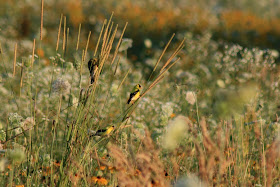By Beth Sullivan
Surely every season has its fans.
Each one can be considered perfect for some reason, an excuse for
being out on a trail. I would guess, though, that autumn is probably
the top vote-getter for a lot of reasons.
Finally the air has cleared of the
oppressive humidity. It’s actually been enjoyable to pull on a
fleece in the morning, and more enjoyable to take it off in the
afternoon warmth. We can happily don hiking boots that give us good
footing to get out on rougher trails and put away the flip flops.
 |
| There is more light in the early autumn woodland. |
 |
| An autumn meadow is most inviting. |
Clear skies
There is a clarity of color we
haven’t seen for months. The blue of the sky is a perfect
complement for the gold-hued leaves. And the perfect match for the
Blue Jays acting like gangs of rowdy teens blasting noisily through
the trees.
Because the leaves have begun
falling already, the density of the green is lessened. There is more
space in the woodland view, and those spaces are filled with
sunlight. Some people complain that the “deep dark woods” of
summer can feel too close, claustrophobic. I never feel that, but
understand, and now that there is more light and an airy feeling,
those folks can feel more comfortable with a longer view. While it
is not as stark and open as it will be in another month, we can now
see some of the more hidden treasures that summer covered up. The
rocky outcrops covered in green moss, reflecting pools along the
brook runs with leaves mirrored, and chipmunks that blend in with the
leaves and hide in the walls. The autumn fields are at their most
beautiful with grasses now at their peak.
 |
| Keep your eyes on the ground when the footing is tricky - |
 |
| But, stop to look up at blue sky and golden leaves. |
Enjoy, but stay alert
But there are some things to be wary
of. Lest you become besotted by the beauty of an open field of
gorgeous grasses and decide to wander in for a closer look, remember
that the ticks have re-emerged now and seem to be more abundant than
in previous months.
In the woods, the leaves are already
falling and they can obscure rocks and roots that may be an accident
waiting to happen. On trails that are not heavily traveled, the
trail itself may be hard to discern, so keep your eyes out for the
blazes. On a recent hike with a lovely group of senior residents
from Stone Ridge, their grounds manager took it upon himself to
actually blow off the leaves from the entire trail we were to walk.
That was true dedication and care.
Cool and frosty mornings leave rocks
slippery, and remember the rocks can stay moist or icy even after the
rest of the ground has warmed up. You know the warning about “bridges
freeze before roads”. That is true in the woods as well. Wooden
bridges can be slippery when damp, so please be careful.
So don’t forget your bug spray,
tuck those pants into socks, grab a hiking stick, and enjoy the next
weeks of very beautiful hiking. Take a camera, too, and share your
photos with us either on Facebook, Instagram, or send those special
beauties to avaloniaphotos@gmail.com
and we may be able to use them in our media.
 |
| When leaves cover the trail, follow the blazes. |
 |
| Bridges can be slippery, so hold on. |
 |
| Chipmunks are in abundance this season. |
 |
| Golden reflections in still water. |
Photographs by Beth Sullivan.






















